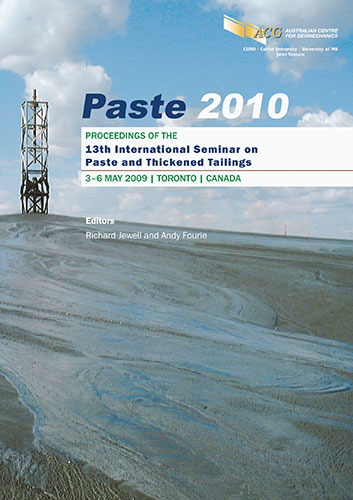Advantages of bolted tank construction for paste thickeners

|
Authors: Rosart, JW |
DOI https://doi.org/10.36487/ACG_rep/1063_35_Rosart
Cite As:
Rosart, JW 2010, 'Advantages of bolted tank construction for paste thickeners', in R Jewell & AB Fourie (eds), Paste 2010: Proceedings of the Thirteenth International Seminar on Paste and Thickened Tailings, Australian Centre for Geomechanics, Perth, pp. 403-410, https://doi.org/10.36487/ACG_rep/1063_35_Rosart
Abstract:
For liquid containment tanks there are many benefits in using bolted joint construction rather than site welding. Some of these include faster assembly time, better quality surface treatments, lower site costs from reduced personnel and equipment, and the ability to easily move the tank to a different location. These factors make bolted tank construction attractive to many industries. However, in thickening applications the vast majority of tanks are site welded. There are two key reasons why thickener users do not consider bolted tank construction more often: • a higher capital cost for the thickener due to the significant number of bolts, flanges and associated fabrication costs • uncertainty about the design of a safe and reliable bolted joint, especially for larger tanks. Both of these considerations are important and should be evaluated carefully. Often, the higher initial capital cost will translate into total project savings by replacing hundreds of metres of site welds and painting with simple bolt tightening and torque inspection. For a typical welded thickener installation of 12 weeks it is common for an equivalent bolted design to take four to six weeks with less manpower. Confidence in joint design comes down to good engineering, testing and field experience. If all three of these conditions are met then the risk of leaking joints is minimal. This paper presents some comparisons of bolted and welded tank designs for paste thickeners and evaluates the total cost, time and risk considerations for each. Some examples of successful bolted thickener installations are shown.
References:
ANSI/API Specification 12B (2008) Specification for Bolted Tanks for Storage of Production Liquids, 15th Edition,
American Petroleum Institute, Washington D.C., USA.
API Standard 650 (2009) Welded Steel Tanks for Oil Storage, 11th Edition, Addendum 2, American Petroleum
Institute, Washington D.C., USA.
© Copyright 2025, Australian Centre for Geomechanics (ACG), The University of Western Australia. All rights reserved.
View copyright/legal information
Please direct any queries or error reports to repository-acg@uwa.edu.au
View copyright/legal information
Please direct any queries or error reports to repository-acg@uwa.edu.au